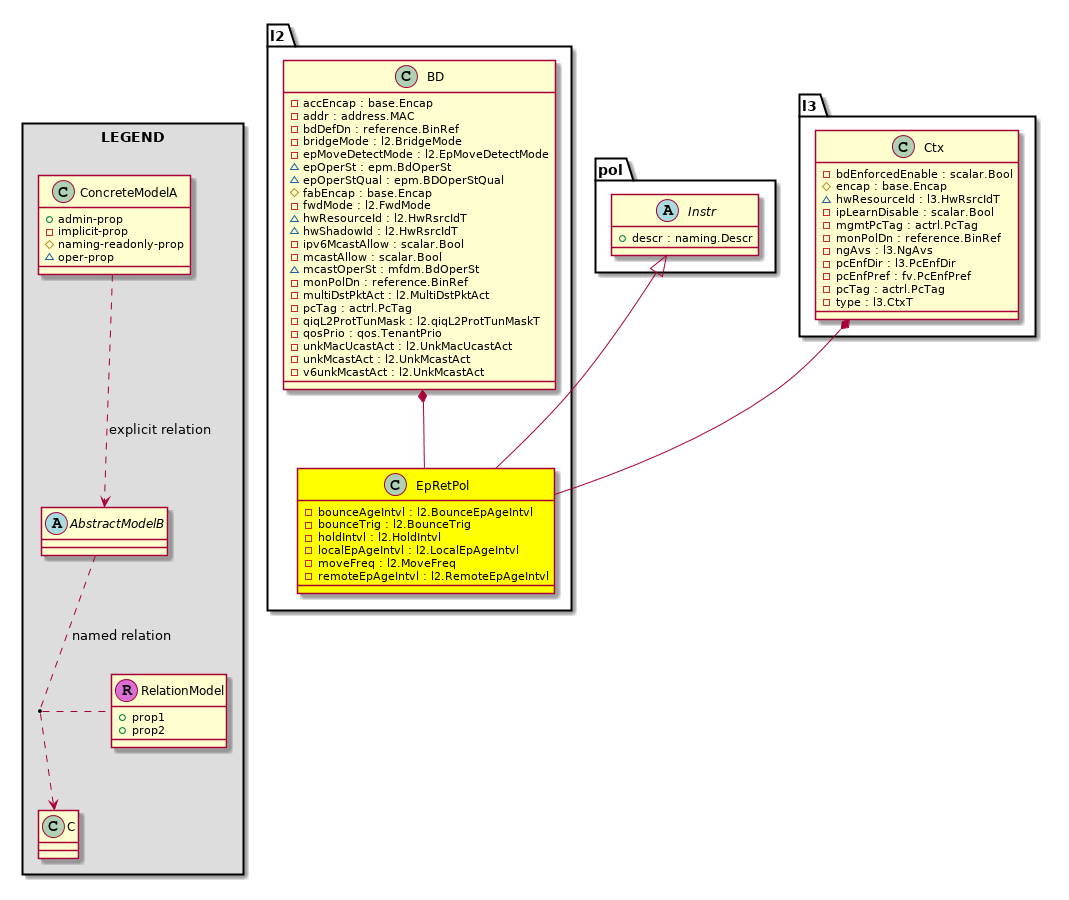| Properties Summary |
| Defined in: mo:Resolvable |
mo:Owner
scalar:Enum8
|
lcOwn (mo:Resolvable:lcOwn)
A value that indicates how this object was created. For internal use only.
|
bounceAgeIntvl
Type: l2:BounceEpAgeIntvl
Primitive Type: scalar:Uint16
Units: sec
Encrypted: false
Access: implicit
Category: TopLevelRegular
Comments:
-
Represents aging interval for bounce entry @@@ Used when the Ep (VM) is moving from one TOR @@@ to another TOR. Ep is marked as bouncing for the @@@ specified age interval and is deleted afterwards
| |
| Constants |
| infinite |
0 |
Infinite |
NO COMMENTS
|
| defaultValue |
630 |
--- |
NO COMMENTS
|
|
bounceTrig
Type: l2:BounceTrig
Primitive Type: scalar:Bitmask8
Units: null
Encrypted: false
Access: implicit
Category: TopLevelRegular
Comments:
-
Bounce trigger
| |
| Constants |
| rarp-flood |
1 |
RARP flooding |
RARP Flooding
|
| protocol |
2 |
Protocol |
through protocol magic
|
| DEFAULT |
protocol(2) |
Protocol |
through protocol magic
|
|
childAction
Type: mo:ModificationChildAction
Primitive Type: scalar:Bitmask32
Units: null
Encrypted: false
Access: implicit
Category: TopLevelChildAction
Comments:
-
Delete or ignore. For internal use only.
| |
| Constants |
| deleteAll |
16384u |
deleteAll |
NO COMMENTS
|
| ignore |
4096u |
ignore |
NO COMMENTS
|
| deleteNonPresent |
8192u |
deleteNonPresent |
NO COMMENTS
|
| DEFAULT |
0 |
--- |
This type is used to
|
|
descr
Type: naming:Descr
Primitive Type: string:Basic
Like: naming:Described:descr
Units: null
Encrypted: false
Access: admin
Category: TopLevelRegular
Comments:
-
Specifies a control instrumentation description.
dn
Type: reference:BinRef
Units: null
Encrypted: false
Access: implicit
Category: TopLevelDn
Comments:
-
A tag or metadata is a non-hierarchical keyword or term assigned to the fabric module.
holdIntvl
Type: l2:HoldIntvl
Primitive Type: scalar:Uint16
Units: sec
Encrypted: false
Access: implicit
Category: TopLevelRegular
Comments:
-
If the EP move frequency is exceeded
| |
| Constants |
| defaultValue |
300 |
--- |
NO COMMENTS
|
|
lcOwn
Type: mo:Owner
Primitive Type: scalar:Enum8
Units: null
Encrypted: false
Access: implicit
Category: TopLevelRegular
Comments:
-
A value that indicates how this object was created. For internal use only.
| |
| Constants |
| local |
0 |
Local |
NO COMMENTS
|
| policy |
1 |
Policy |
NO COMMENTS
|
| replica |
2 |
Replica |
NO COMMENTS
|
| resolveOnBehalf |
3 |
ResolvedOnBehalf |
NO COMMENTS
|
| implicit |
4 |
Implicit |
NO COMMENTS
|
| DEFAULT |
local(0) |
Local |
NO COMMENTS
|
|
localEpAgeIntvl
Type: l2:LocalEpAgeIntvl
Primitive Type: scalar:Uint16
Units: sec
Encrypted: false
Access: implicit
Category: TopLevelRegular
Comments:
-
This represents aging interval for all local endpoints learned in this BD. Once we reach 75% of this interval is reached
| |
| Constants |
| infinite |
0 |
Infinite |
NO COMMENTS
|
| defaultValue |
900 |
--- |
NO COMMENTS
|
|
modTs
Type: mo:TStamp
Primitive Type: scalar:Date
Units: null
Encrypted: false
Access: implicit
Category: TopLevelRegular
Comments:
-
The time when this object was last modified.
| |
| Constants |
| never |
0ull |
never |
NO COMMENTS
|
| DEFAULT |
never(0ull) |
never |
NO COMMENTS
|
|
moveFreq
Type: l2:MoveFreq
Primitive Type: scalar:Uint16
Units: sec
Encrypted: false
Access: implicit
Category: TopLevelRegular
Comments:
-
EP move frequency
| |
| Constants |
| none |
0 |
No Move Frequency is Enforced |
NO COMMENTS
|
| defaultValue |
256 |
--- |
NO COMMENTS
|
|
name
Type: naming:Name
Primitive Type: string:Basic
Overrides:naming:NamedObject:name
Units: null
Encrypted: false
Access: admin
Category: TopLevelRegular
Comments:
-
null
nameAlias
Type: naming:NameAlias
Primitive Type: string:Basic
Units: null
Encrypted: false
Access: admin
Category: TopLevelRegular
Comments:
-
NO COMMENTS
remoteEpAgeIntvl
Type: l2:RemoteEpAgeIntvl
Primitive Type: scalar:Uint16
Units: sec
Encrypted: false
Access: implicit
Category: TopLevelRegular
Comments:
-
This represents aging interval for all remote endpoints learned in this BD. The remote endpoints are learned through conversational learning
| |
| Constants |
| infinite |
0 |
Infinite |
NO COMMENTS
|
| defaultValue |
300 |
--- |
NO COMMENTS
|
|
rn
Type: reference:BinRN
Units: null
Encrypted: false
Access: implicit
Category: TopLevelRn
Comments:
-
Identifies an object from its siblings within the context of its parent object. The distinguished name contains a sequence of relative names.
status
Type: mo:ModificationStatus
Primitive Type: scalar:Bitmask32
Units: null
Encrypted: false
Access: implicit
Category: TopLevelStatus
Comments:
-
The upgrade status. This property is for internal use only.
| |
| Constants |
| created |
2u |
created |
In a setter method: specifies that an object should be created.
An error is returned if the object already exists.
In the return value of a setter method: indicates that an object has been created.
|
| modified |
4u |
modified |
In a setter method: specifies that an object should be modified
In the return value of a setter method: indicates that an object has been modified.
|
| deleted |
8u |
deleted |
In a setter method: specifies that an object should be deleted.
In the return value of a setter method: indicates that an object has been deleted.
|
| DEFAULT |
0 |
--- |
This type controls the life cycle of objects passed in the XML API.
When used in a setter method (such as configConfMo), the ModificationStatus
specifies whether an object should be created, modified, deleted or removed.
In the return value of a setter method, the ModificationStatus indicates the actual
operation that was performed. For example, the ModificationStatus is set to "created"
if the object was created. The ModificationStatus is not set if the object was neither
created, modified, deleted or removed.
When invoking a setter method, the ModificationStatus is optional:
If a setter method such as configConfMo is invoked and the ModificationStatus
is not set, the system automatically determines if the object should be created or modified.
|
|

